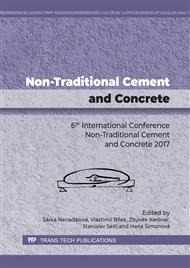p.92
p.96
p.103
p.111
p.116
p.120
p.127
p.131
p.135
Effect of Plasticizing Admixtures on the Development of Hydration Temperatures and the Properties of Cement Pastes
Abstract:
The hydration of cement is a very intricate process. A great amount of heat is generated during the reaction, which requires close monitoring especially in large concrete members. Modified cement pastes are simpler systems and can be easily used to observe the effect of plasticizing admixtures on the development of temperatures during cement hydration as well as its rheology and mechanical properties. Knowledge of the development of hydration temperatures can be of assistance in deliberate regulation of cement hydration and the generation of hydration heat. The paper describes what influence different amounts of different plasticizers have on the properties of cement pastes, with added focus on the development of their hydration temperatures, rheology and compressive strength.
Info:
Periodical:
Pages:
116-119
Citation:
Online since:
January 2018
Authors:
Price:
Сopyright:
© 2018 Trans Tech Publications Ltd. All Rights Reserved
Share:
Citation:


